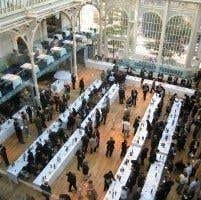This is a longer version of an article also published in the Financial Times.
The most interesting thing I learnt at last month’s tasting of smart 2006 bordeaux in bottle in London was that Frédéric Castéja, son of powerful Bordeaux négociant Philippe Castéja, was to marry the daughter of Xavier Borie of Château Grand Puy Lacoste that Saturday at Bordeaux’s commercial match of the year. Well over 1,200 people were expected so that the bride’s Pauillac classed growth property proved too small and the celebrations were held at the groom’s family’s Pauillac estate, Château Lynch Moussas. Not nearly such a good wine but a bigger entertaining space.
I had hoped to come away with more than this. Ideally a revision of my initial impressions of the 2006 vintage as being great for white wines but a definite disappointment for reds – especially in view of the fact that 2007 and 2008 look unlikely to knock our socks off. Alas, those underripe tannins and occasional green notes were still there in many of the reds – although my tasting of more than a hundred wines did at least identify some reds that outshine the norm.

As usual, most unfortunately for us tasters, the first growths and the likes of Châteaux Angélus, Calon Ségur, Cos d’Estournel, Ducru-Beaucaillou, L’Evangile, Léoville Las Cases, Montrose, Palmer, Pavie and Vieux Château Certan were absent from the range shown last week by the Union des Grands Crus de Bordeaux, but fortunately we were able to taste virtually all other top reds from the left bank (Médoc and Graves) and many sterling representatives of the St-Émilion and Pomerol establishment.
In fact, as a group these particular St-Émilions showed better than the reds of any other appellation, clearly benefiting from their fleshy Merlot grapes having been picked before the rains that so unfortunately interrupted the Bordeaux grape harvest in 2006 (and left their mark in no uncertain fashion on the 2007 and 2008 harvests too). Many fine Pomerols were also made in 2006 but were absent from this Union des Grands Crus selection, leaving Ch La Conseillante to shine most brightly in London last month.
In general these right bank wines were free of the besetting sins of the Cabernet-dominated wines of the Médoc, where, despite many of them having delightfully fresh fruit and even some quite interesting scents, it was hard to ignore the fact that the grapes were so much less ripe than in 2005 – particularly from the point of view of the austerity of the tannins. Occasionally there would be a whiff of green, underripe fruit on some Médoc wines but perhaps the real miracle in this disease-prone year is that throughout the tasting I caught not the slightest hint of any rot. This was the year of the sorting table.
In Pauillac the Pichons had both clearly used theirs to great effect, vying with each other more obviously than in, say, 2005 for the crown, with both Pichon Lalande and Pontet Canet seeming to have put on flesh. (Some other 2006s which charmed en primeur seem to lack real substance for long-term ageing.) Just down the road in St-Julien, the two Barton wines were clearly head and shoulders above their neighbours, with Langoa being even more seductive than usual at this relatively early stage.
So when might the reds of this serviceable if not wildly exciting vintage be ready to drink? My suggested drinking dates for most of the right bank wines were in the range of 2012-20 with the grander left bank wines probably having a rather longer drinking life. They certainly lack the exceptional stuffing of the 2005s so in general could and probably should be drunk before the 2005s – although it will be difficult to resist the gorgeous plumpness of the 2005s unless they retreat much more significantly into their shell than they have done so far.
As for Graves and its Pessac-Léognan elite, they were showing rather well last month. Again, picking before the mid-September rains doubtless helped the dry whites and many of the reds. In general I see that my scores were rather less enthusiastic on re-tasting than when I tasted these wines en primeur in April 2007, although there were exceptions. Some of the Sauternes, Suduiraut, even Broustet and especially Doisy Daëne, showed much better now that they are in bottle and I think there will be some very nice medium-term sweet 2006s.
But as for the reds, it is very difficult to see why one should pay so much more for this vintage than for the 2004s and especially the 2001s, which have already achieved so much more of their interesting development in bottle. After all, that is the point of red Bordeaux.
My favourite 2006s from the UGC tasting appear below. Those listed got 16.5 points, those with one * got 17 and those with ** I scored 17.5.
REDS
Ch Brane Cantenac, Margaux
Ch Desmirail, Margaux
Ch Prieuré-Lichine, Margaux
*Ch Rauzan-Ségla, Margaux
*Ch Langoa-Barton, St-Julien
*Ch Léoville-Barton, St-Julien
Ch d’Armailhac, Pauillac
Ch Lynch Bages, Pauillac
*Ch Pichon-Longueville, Pauillac
*Ch Pichon-Lalande, Pauillac
Ch Pontet-Canet, Pauillac
Ch Lafon Rochet, St-Estèphe
Ch Chantegrive, Graves
Dom de Chevalier, Pessac-Léognan
Ch Malartic-Lagravière, Pessac-Léognan
Ch Smith-Haut-Lafitte, Pessac-Léognan
Ch Balestard La Tonnelle, St-Emilion
*Ch Canon, St-Émilion
*Ch Figeac, St-Émilion
*Clos Fourtet, St-Émilion
*Ch La Couspade, St-Émilion
Ch La TourFigeac, St-Émilion
Ch Troplong Mondot, St-Émilion
**Ch La Conseillante, Pomerol
DRY WHITES
Ch Bouscaut, Pessac-Léognan
Dom de Chevalier, Pessac-Léognan
Ch de Fieuzal, Pessac-Léognan
Ch Pape-Clément, Pessac-Léognan
*Ch Smith Haut-Lafitte, Pessac-Léognan
SWEET WHITES
Ch Broustet, Barsac
**Ch Climens, Barsac
*Ch Coutet, Barsac
Ch de Fargues, Sauternes
Ch de Rayne Vigneau, Sauternes
Ch Doisy Daëne, Barsac
Ch Doisy Védrines, Barsac
*Ch La Tour Blanche, Sauternes
*Ch Lafaurie-Peyraguey, Sauternes
*Ch Suduiraut, Sauternes

